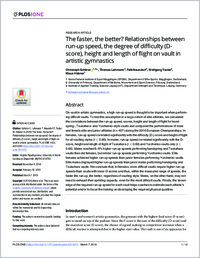The faster, the better? Relationships between run-up speed, the degree of difficulty (D-score), height and length of flight on vault in artistic gymnastics
- Schärer, Christoph Swiss Federal Institute of Sport Magglingen (SFISM), Department of Elite Sports, Magglingen, Switzerland, - University of Fribourg, Department of Medicine, Movement and Sport Science, Fribourg, Switzerland,
- Lehmann, Thomas Institute of Applied Training Science Leipzig (IAT), Department Strength and Technique, Leipzig, Germany
- Naundorf, Falk Institute of Applied Training Science Leipzig (IAT), Department Strength and Technique, Leipzig, Germany
- Taube, Wolfgang University of Fribourg, Department of Medicine, Movement and Sport Science, Fribourg, Switzerland,
- Hübner, Klaus Swiss Federal Institute of Sport Magglingen (SFISM), Department of Elite Sports, Magglingen, Switzerland,
- 07.03.2019
Published in:
- PLOS ONE. - 2019, vol. 14, no. 3, p. e0213310
English
On vault in artistic gymnastics, a high run-up speed is thought to be important when performing difficult vaults. To test this assumption in a large cohort of elite athletes, we calculated the correlations between the run-up speed, scores, height and length of flight for handspring-, Tsukahara- and Yurchenko-style vaults and compared the performances of male and female elite and junior athletes (n = 407) during the 2016 European Championships. In females, run-up speed correlated significantly with the difficulty (D-) score and height of flight for all vaulting styles (r ≤ 0.80). In males, run-up speed correlated significantly with the D-score, height and length of flight of Tsukahara (r ≤ 0.69) and Yurchenko vaults only (r ≤ 0.65). Males reached 8–9% higher run-up speeds performing handspring and Tsukahara vaults than did females, but similar run- up speeds performing Yurchenko vaults. Elite females achieved higher run-up speeds than junior females performing Yurchenko vaults. Elite males displayed higher run-up speeds than junior males performing handspring and Tsukahara vaults. We conclude that, in females, more difficult vaults require higher run-up speeds than vaults with lower D-scores and thus, within the measured range of speeds, the faster the run-up, the better, regardless of vaulting style. Males, on the other hand, may not need to exhaust their sprinting capacity, even for the most difficult vaults. Finally, the knowledge of the required run-up speed for each vault helps coaches to estimate each athlete’s potential and/or to focus the training on developing the required physical qualities.
- Faculty
- Faculté des sciences et de médecine
- Department
- Département de Médecine
- Language
-
- English
- Classification
- Sports sciences
- License
-
License undefined
- Identifiers
-
- RERO DOC 324691
- DOI 10.1371/journal.pone.0213310
- Persistent URL
- https://folia.unifr.ch/unifr/documents/307749
Statistics
Document views: 149
File downloads:
- pdf: 214
